Glue Putty
Polymer Putty is made from the reaction between glue, which is made up of droplets of a polymer called polyvinyl acetate suspended in water, and borax. The borax crosslinks the polymer and a network structure is formed. The putty is held together by very weak intermolecular bonds that provide flexibility. If the cross-linked bonds in a polymer are strong and permanent, the network is called a thermosetting plastic. This material does not soften when heated, but instead it decomposes at high temperature. If the bonds are weak and non-permanent, as in this case, the network polymer can be considered a thermoplastic or elastomer. If the rigidity of a polymer decreases when a critical temperature is reached, the polymer is called a thermoplastic. Elastomers have elastic properties, that is, they will recover their original size and shape after being deformed. Examples of elastomers are rubber bands and automobile tires.The putty is non-toxic, but the borax can be irritating to the eyes, so use safety glasses and wash hands at the end of the experiment. The putty may stain clothing and carpeting, so care should be exercised. Vinegar will help clean up any putty from clothing or carpeting. It should be discarded in the trash and NOT down the drain, as it may clog the drainpipe. Putty tends to dry out if left exposed to the air, so store it in a sealed plastic bag.
Supplies needed:
- Craft Glue (such as Elmer's®)
- Borax solution (instructions for preparation included below)
- Small (3 oz) cup
- Plastic teaspoon
- Wooden stick
- Waxed paper
Procedure:
1. Measure 2 tsp. of white (or colored) glue into a cup.
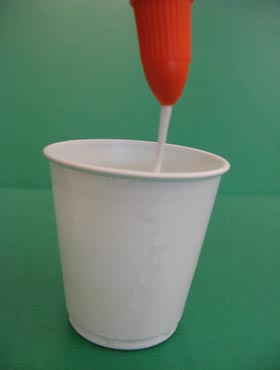
2. Add 1 tsp. of borax solution and stir well with a wooden stick.
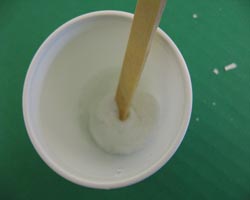
3. After a couple of minutes of mixing, the putty should be taken out of the cup and kneaded in the hands. Don't worry about the material sticking to your hands as these pieces will soon mix with the larger quantity with which you are working.
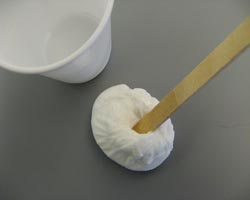
4. Continue to knead until the desired consistency is reached. Roll it into a ball on the waxed paper. Is it easy to roll into a ball? Does it bounce?
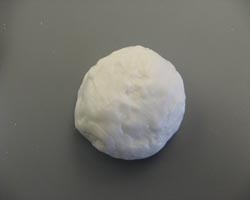
5. Let the ball sit for a while. What happens to it?
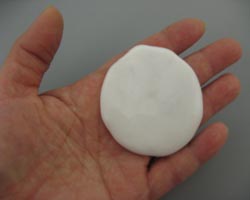
6. Try to pull the putty apart quickly. Next try to pull it apart very slowly. Describe how it behaves. Try cutting the Putty with a spoon. Is it a liquid or a solid? Support your answer with observations.
This polymer putty is unique because it has qualities of both a solid and a liquid. It can take the shape of its containers like a liquid does, yet you can hold it in your hand and pick it up like a solid. Such behavior is called "viscoelasticity" and materials that exhibit this behavior are said to be "viscoelastic".
There are a number of variations that can be made to this experiment. By adding 1 teaspoon of talcum powder or cornstarch to the putty in the first step, the properties can be changed. The talcum powder or cornstarch act as "filler" and result in a very different product and behavior. In industry, fillers such as talc and carbon black are added to crosslinked polymers to adjust and vary properties such as color and strength. Filler also reduces the cost of the product since the filler materials are generally inexpensive.
You can also use clear gel glue (we use Galaxy glue which is a blue) in place of Elmer's glue. It is always a good idea to check the amounts of glue and borax needed if you use a different kind of glue, since glue manufacturers' formulations differ. This experiment can also be carried out in a Ziplock® plastic bag instead of a cup.
Shape the putty into a ball and put it in the refrigerator or freezer to cool it below room temperature. Be sure it is in a plastic bag or wrapped in plastic wrap so it won't dry out. Cooling putty improves its ability to bounce, however, if it gets too cold, the putty will become brittle and shatter. Bounce the putty before and after cooling and compare the results. Polymer putty has a rebound of 80%, meaning it will bounce back 80 percent of the height it's dropped.
The material prepared in this experiment is a type of Silly Putty®. The original Silly Putty® was prepared using a different polymer called sodium silicate and mixing this with borax. Silly Putty®, one of America's classic toys, is over 50 years old. It was first developed as a rubber substitute during World War II.
PREPARATION OF SOLUTIONS FOR THIS EXPERIMENT:
4% Sodium Borate, Na2B4O7 * 10 H2O, Solution
- Dissolve 10 grams of sodium borate in 250 ml of distilled water. You can obtain Borax at the grocery store near the laundry detergent.